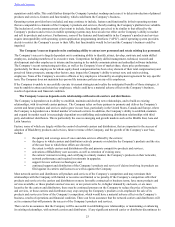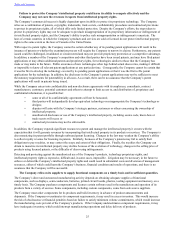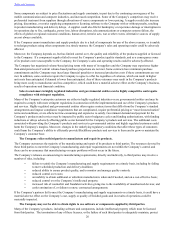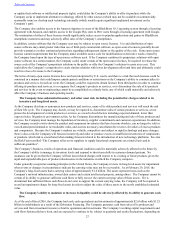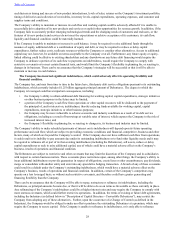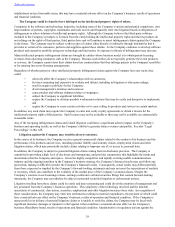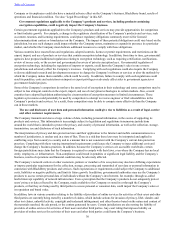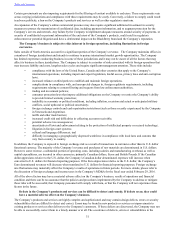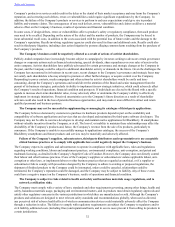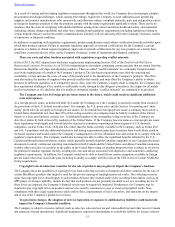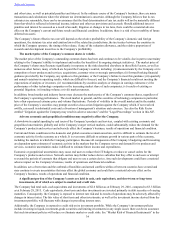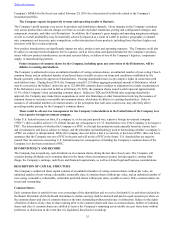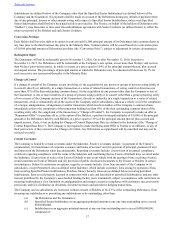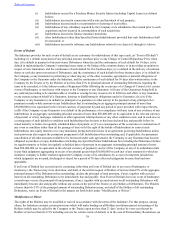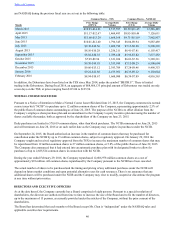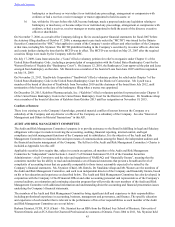Blackberry 2016 Annual Report Download - page 42
Download and view the complete annual report
Please find page 42 of the 2016 Blackberry annual report below. You can navigate through the pages in the report by either clicking on the pages listed below, or by using the keyword search tool below to find specific information within the annual report.
Table of Contents
33
As a result of varying and developing regulatory requirements throughout the world, the Company faces increasingly complex
procurement and design challenges, which, among other things, require the Company to incur additional costs identifying
suppliers and contract manufacturers who can provide, and otherwise obtain, compliant materials, parts and end products and to
re-design its hardware products so that the products comply with the many requirements applicable to them. There can be no
assurance that the costs of complying with and the liabilities arising from current and future health and safety, environmental
(including climate change regulation) and other laws, standards and regulatory requirements (including legislation relating to
certain minerals that are used in the mobile communications industry) will not adversely affect the Company’s business, results
of operations or financial condition.
In addition to complying with regulatory requirements, product manufacturers must obtain certification from the networks upon
which their products operate. Failure to maintain regulatory approvals or network certifications for the Company’s current
products or a failure to obtain required regulatory approvals or network certifications for any new products on a timely basis
could have a material adverse effect on the Company’s business, results of operations and financial condition.
There are costs and other burdens associated with regulations regarding conflict minerals.
In fiscal 2015, the SEC adopted new disclosure requirements implementing Section 1502 of the Dodd-Frank Wall Street
Reform and Consumer Protection Act of 2010 for manufacturers of products containing certain minerals that are mined from the
Democratic Republic of Congo and adjoining countries. These so-called “conflict minerals” are commonly found in metals
used in the manufacture of certain of the Company’s products. The disclosure requirements may limit the sourcing and
availability, or may increase the costs, of some of the metals used in the manufacture of the Company’s products. The effect
may also reduce the number of suppliers who provide conflict-free metals, and may affect the Company’s ability to obtain
products in sufficient quantities or at competitive prices. Also, since the Company’s supply chain is complex, the Company may
face reputational challenges if it is unable to sufficiently verify, through its due diligence procedures, the origins for all metals
used in its products or if it discloses that it is unable to determine whether “conflict minerals” are contained in its products.
The Company may lose its foreign private issuer status in the future, which could result in significant additional
costs and expenses.
As a foreign private issuer, as defined in Rule 3b-4 under the Exchange Act, the Company is currently exempt from certain of
the provisions of the U.S. federal securities laws. For example, the U.S. proxy rules and the Section 16 reporting and “short
swing” profit rules do not apply to foreign private issuers. To be considered a foreign private issuer, a company must satisfy a
United States shareholder test (less than 50% of the voting securities of a company must be held by residents of the United
States) or a three part business contacts test. A substantial number of the outstanding voting securities of the Company are
directly or indirectly held of record by residents of the United States. If the Company loses its status as a foreign private issuer,
these regulations would apply and it would also be required to commence reporting on forms required of U.S. domestic
companies, such as Forms 10-K, 10-Q and 8-K, rather than the forms currently available to the Company, such as Forms 40-F
and 6-K. Compliance with the additional disclosure and timing requirements under these securities laws would likely result in
increased expenses and would require the Company’s management to devote substantial time and resources to comply with new
regulatory requirements. The Company would also no longer be able to utilize the significant benefits afforded by the U.S./
Canada multijurisdictional disclosure system, which generally permits eligible Canadian companies to use Canadian disclosure
documents to satisfy continuous reporting requirements in both Canada and the United States, and allows Canadian companies
to make offers and sales of securities to the public in the United States using a Canadian prospectus that is subject to review by
the principal Canadian regulator, thereby avoiding the costs and delays associated with duplicative and sometimes conflicting
regulatory requirements. In addition, the Company would not be able to benefit from certain exemptions available to foreign
private issuers that it has used in the past, including its ability to comply with the rules of the TSX in lieu of certain NASDAQ
listing requirements.
Copyright levies in numerous countries for the sale of products may negatively impact the Company’s business.
The Company faces the possibility of copyright levies from collecting societies in European and other countries for the sale of
certain BlackBerry products that might be used for the private copying of copyright protected works. The collecting societies
argue that copyright levies should apply to such products because they include audio/video recording functionality, such as an
MP3 player or storage capability, despite the fact that such products are not primarily intended to act as a recording device. If
these levies are imposed, the Company’s financial results may be negatively impacted. Furthermore, the Company may be
required to pay copyright levies on products and services used by consumers to copy or stream copyrighted works. Non-
compliance with these legal requirements could result in fines, imprisonment of local executives, and sanctions on the import
and/or use of the Company’s products or services.
Tax provision changes, the adoption of new tax legislation or exposure to additional tax liabilities could materially
impact the Company’s financial condition.
The Company is subject to income, indirect (such as sales tax, sales and use tax and value-added tax) and other taxes in Canada
and numerous foreign jurisdictions. Significant judgment is required in determining its worldwide liability for income, indirect


